Data Models and Database Technologies: A Comprehensive Report
VerifiedAdded on 2024/05/17
|12
|1788
|219
Report
AI Summary
This report provides a detailed analysis of various data models, including hierarchical, relational, network, and object-oriented models, comparing their advantages and disadvantages. It also discusses different database schemas such as internal, conceptual, and external. The report critically examines various database technologies like file-based databases, multimedia databases, data warehousing, and cloud computing, highlighting their benefits and limitations. Furthermore, it analyzes top-down and bottom-up approaches to database design, emphasizing the role of entities and attributes in creating ER diagrams. This document, contributed by a student, is available on Desklib, a platform offering a wealth of study resources and solved assignments.
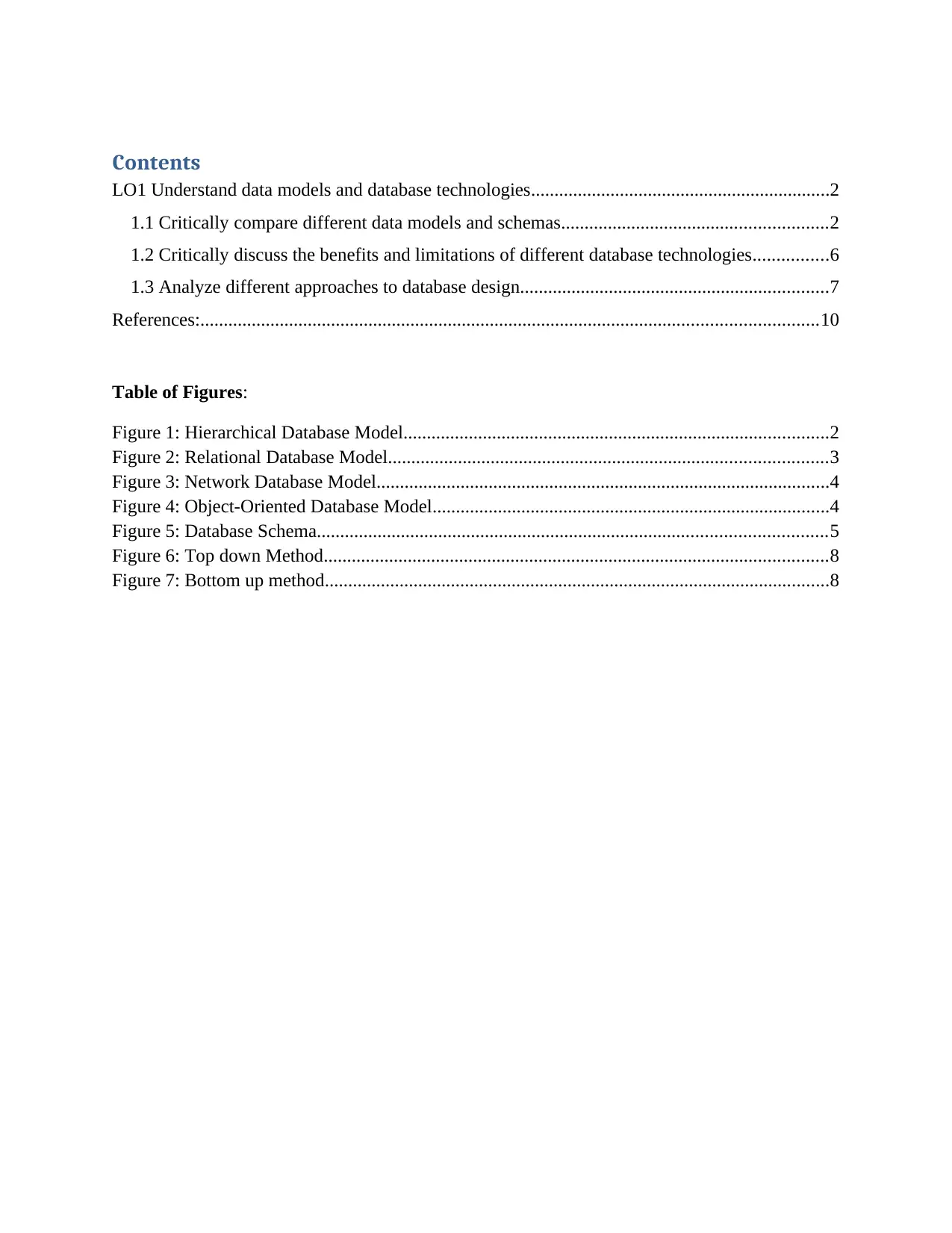
Contents
LO1 Understand data models and database technologies................................................................2
1.1 Critically compare different data models and schemas.........................................................2
1.2 Critically discuss the benefits and limitations of different database technologies................6
1.3 Analyze different approaches to database design..................................................................7
References:....................................................................................................................................10
Table of Figures:
Figure 1: Hierarchical Database Model...........................................................................................2
Figure 2: Relational Database Model..............................................................................................3
Figure 3: Network Database Model.................................................................................................4
Figure 4: Object-Oriented Database Model.....................................................................................4
Figure 5: Database Schema.............................................................................................................5
Figure 6: Top down Method............................................................................................................8
Figure 7: Bottom up method............................................................................................................8
LO1 Understand data models and database technologies................................................................2
1.1 Critically compare different data models and schemas.........................................................2
1.2 Critically discuss the benefits and limitations of different database technologies................6
1.3 Analyze different approaches to database design..................................................................7
References:....................................................................................................................................10
Table of Figures:
Figure 1: Hierarchical Database Model...........................................................................................2
Figure 2: Relational Database Model..............................................................................................3
Figure 3: Network Database Model.................................................................................................4
Figure 4: Object-Oriented Database Model.....................................................................................4
Figure 5: Database Schema.............................................................................................................5
Figure 6: Top down Method............................................................................................................8
Figure 7: Bottom up method............................................................................................................8
Paraphrase This Document
Need a fresh take? Get an instant paraphrase of this document with our AI Paraphraser
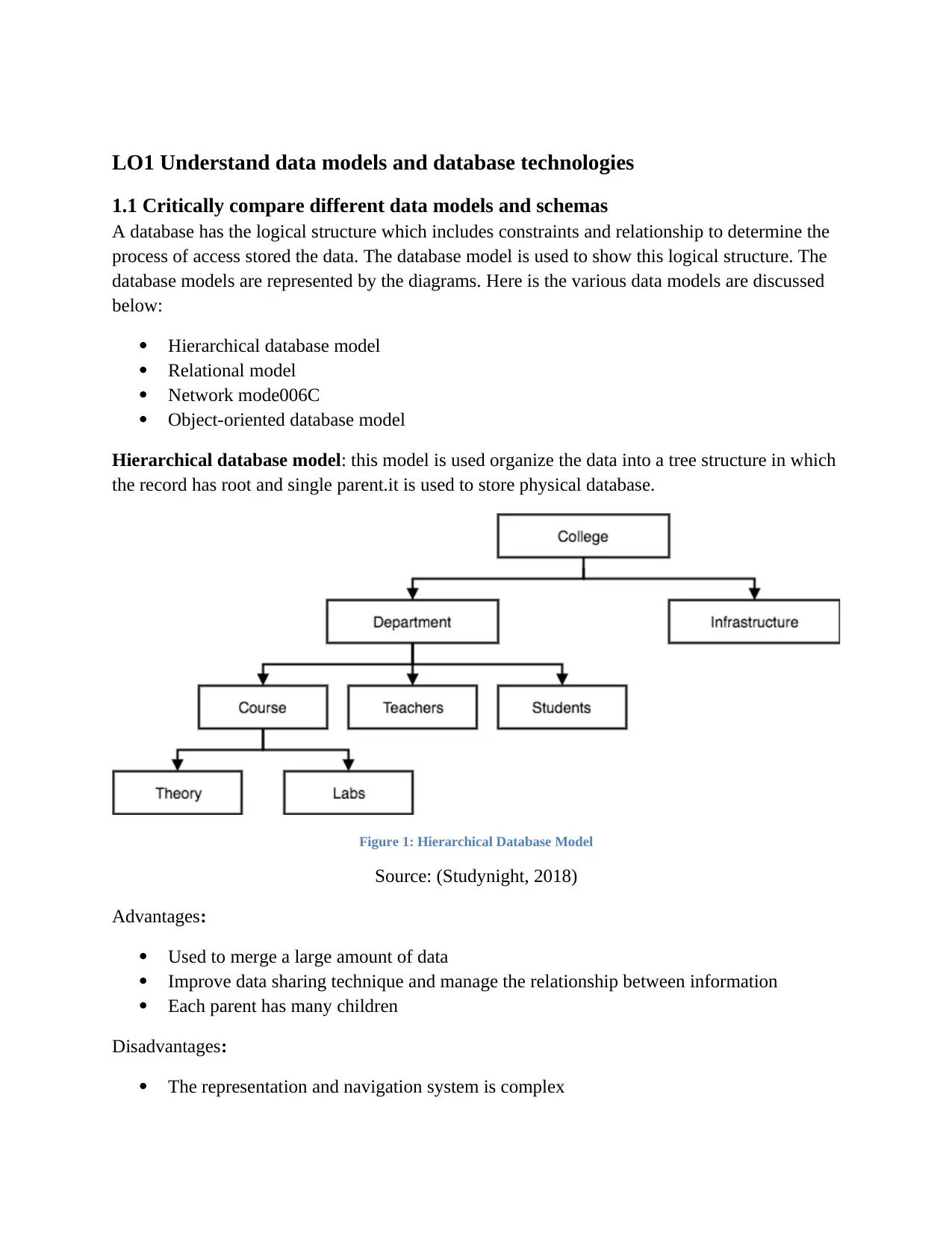
LO1 Understand data models and database technologies
1.1 Critically compare different data models and schemas
A database has the logical structure which includes constraints and relationship to determine the
process of access stored the data. The database model is used to show this logical structure. The
database models are represented by the diagrams. Here is the various data models are discussed
below:
Hierarchical database model
Relational model
Network mode006C
Object-oriented database model
Hierarchical database model: this model is used organize the data into a tree structure in which
the record has root and single parent.it is used to store physical database.
Figure 1: Hierarchical Database Model
Source: (Studynight, 2018)
Advantages:
Used to merge a large amount of data
Improve data sharing technique and manage the relationship between information
Each parent has many children
Disadvantages:
The representation and navigation system is complex
1.1 Critically compare different data models and schemas
A database has the logical structure which includes constraints and relationship to determine the
process of access stored the data. The database model is used to show this logical structure. The
database models are represented by the diagrams. Here is the various data models are discussed
below:
Hierarchical database model
Relational model
Network mode006C
Object-oriented database model
Hierarchical database model: this model is used organize the data into a tree structure in which
the record has root and single parent.it is used to store physical database.
Figure 1: Hierarchical Database Model
Source: (Studynight, 2018)
Advantages:
Used to merge a large amount of data
Improve data sharing technique and manage the relationship between information
Each parent has many children
Disadvantages:
The representation and navigation system is complex
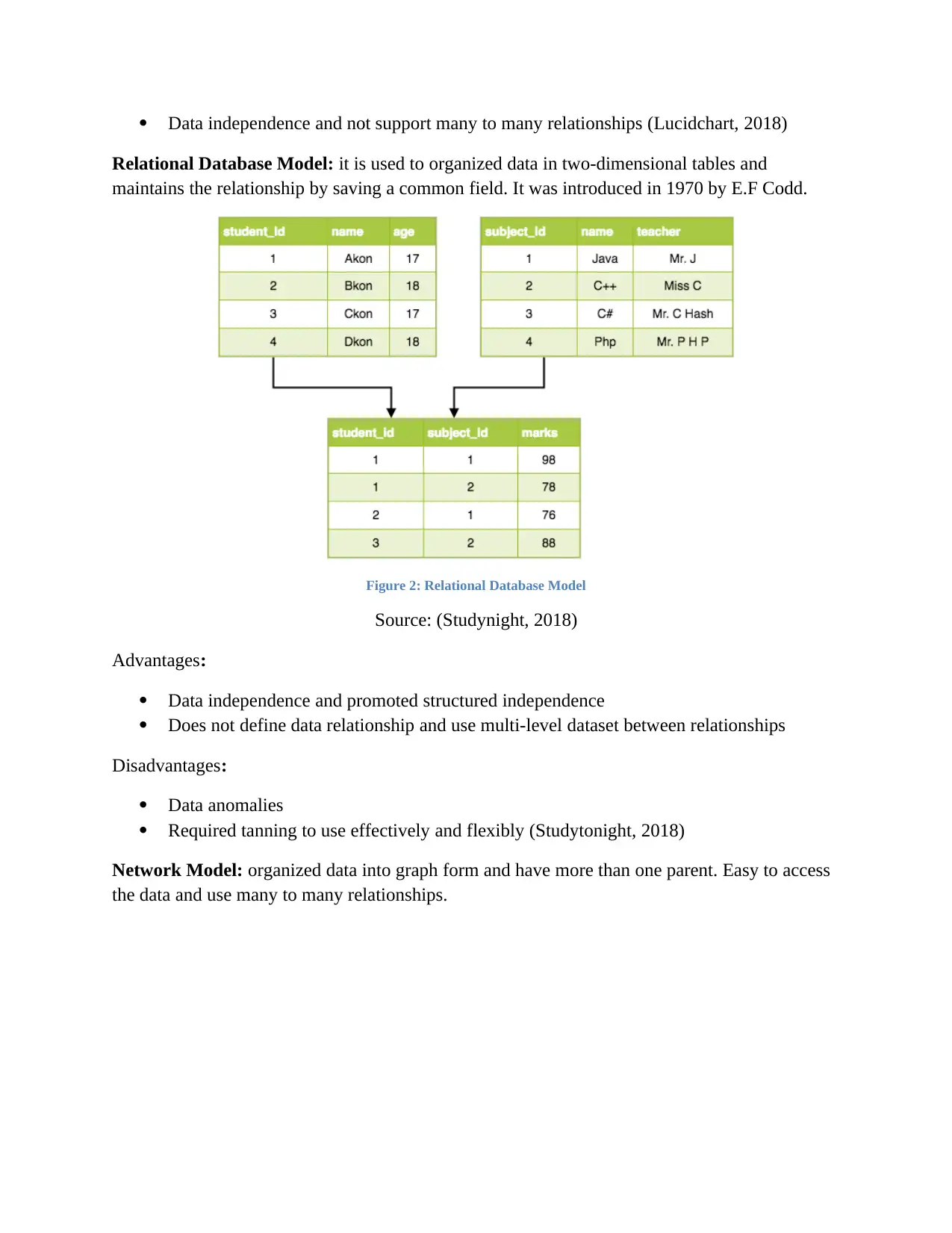
Data independence and not support many to many relationships (Lucidchart, 2018)
Relational Database Model: it is used to organized data in two-dimensional tables and
maintains the relationship by saving a common field. It was introduced in 1970 by E.F Codd.
Figure 2: Relational Database Model
Source: (Studynight, 2018)
Advantages:
Data independence and promoted structured independence
Does not define data relationship and use multi-level dataset between relationships
Disadvantages:
Data anomalies
Required tanning to use effectively and flexibly (Studytonight, 2018)
Network Model: organized data into graph form and have more than one parent. Easy to access
the data and use many to many relationships.
Relational Database Model: it is used to organized data in two-dimensional tables and
maintains the relationship by saving a common field. It was introduced in 1970 by E.F Codd.
Figure 2: Relational Database Model
Source: (Studynight, 2018)
Advantages:
Data independence and promoted structured independence
Does not define data relationship and use multi-level dataset between relationships
Disadvantages:
Data anomalies
Required tanning to use effectively and flexibly (Studytonight, 2018)
Network Model: organized data into graph form and have more than one parent. Easy to access
the data and use many to many relationships.
⊘ This is a preview!⊘
Do you want full access?
Subscribe today to unlock all pages.

Trusted by 1+ million students worldwide
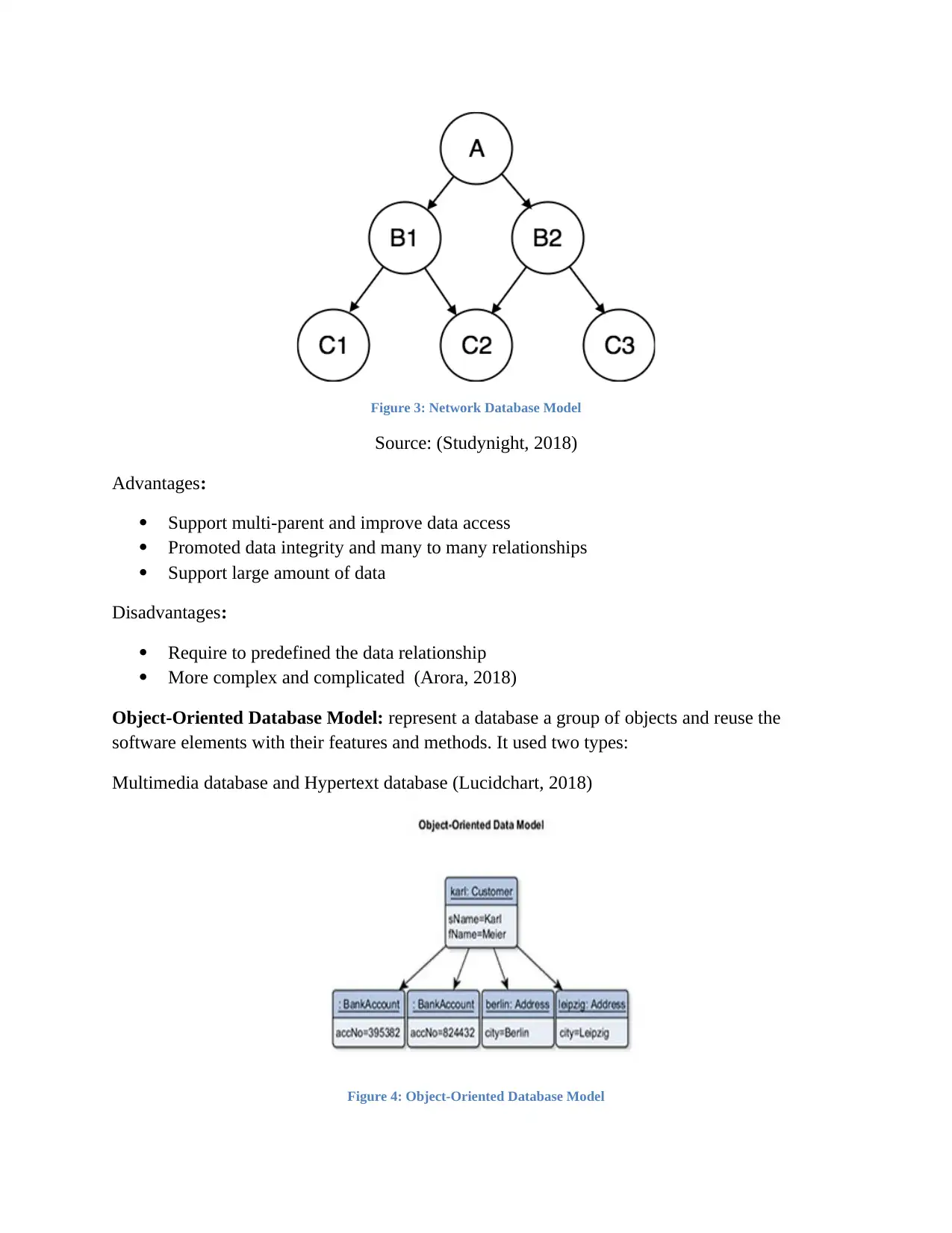
Figure 3: Network Database Model
Source: (Studynight, 2018)
Advantages:
Support multi-parent and improve data access
Promoted data integrity and many to many relationships
Support large amount of data
Disadvantages:
Require to predefined the data relationship
More complex and complicated (Arora, 2018)
Object-Oriented Database Model: represent a database a group of objects and reuse the
software elements with their features and methods. It used two types:
Multimedia database and Hypertext database (Lucidchart, 2018)
Figure 4: Object-Oriented Database Model
Source: (Studynight, 2018)
Advantages:
Support multi-parent and improve data access
Promoted data integrity and many to many relationships
Support large amount of data
Disadvantages:
Require to predefined the data relationship
More complex and complicated (Arora, 2018)
Object-Oriented Database Model: represent a database a group of objects and reuse the
software elements with their features and methods. It used two types:
Multimedia database and Hypertext database (Lucidchart, 2018)
Figure 4: Object-Oriented Database Model
Paraphrase This Document
Need a fresh take? Get an instant paraphrase of this document with our AI Paraphraser
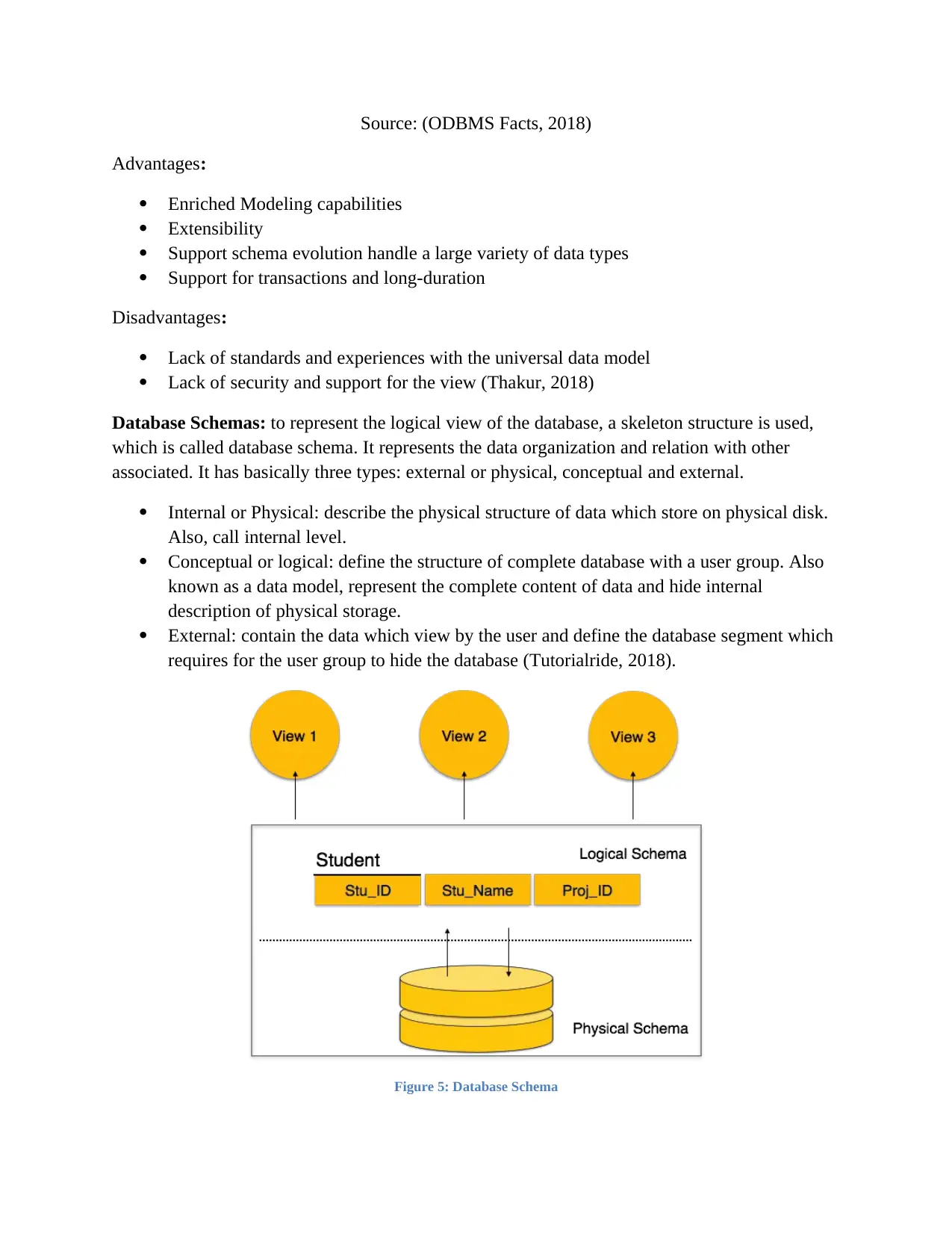
Source: (ODBMS Facts, 2018)
Advantages:
Enriched Modeling capabilities
Extensibility
Support schema evolution handle a large variety of data types
Support for transactions and long-duration
Disadvantages:
Lack of standards and experiences with the universal data model
Lack of security and support for the view (Thakur, 2018)
Database Schemas: to represent the logical view of the database, a skeleton structure is used,
which is called database schema. It represents the data organization and relation with other
associated. It has basically three types: external or physical, conceptual and external.
Internal or Physical: describe the physical structure of data which store on physical disk.
Also, call internal level.
Conceptual or logical: define the structure of complete database with a user group. Also
known as a data model, represent the complete content of data and hide internal
description of physical storage.
External: contain the data which view by the user and define the database segment which
requires for the user group to hide the database (Tutorialride, 2018).
Figure 5: Database Schema
Advantages:
Enriched Modeling capabilities
Extensibility
Support schema evolution handle a large variety of data types
Support for transactions and long-duration
Disadvantages:
Lack of standards and experiences with the universal data model
Lack of security and support for the view (Thakur, 2018)
Database Schemas: to represent the logical view of the database, a skeleton structure is used,
which is called database schema. It represents the data organization and relation with other
associated. It has basically three types: external or physical, conceptual and external.
Internal or Physical: describe the physical structure of data which store on physical disk.
Also, call internal level.
Conceptual or logical: define the structure of complete database with a user group. Also
known as a data model, represent the complete content of data and hide internal
description of physical storage.
External: contain the data which view by the user and define the database segment which
requires for the user group to hide the database (Tutorialride, 2018).
Figure 5: Database Schema
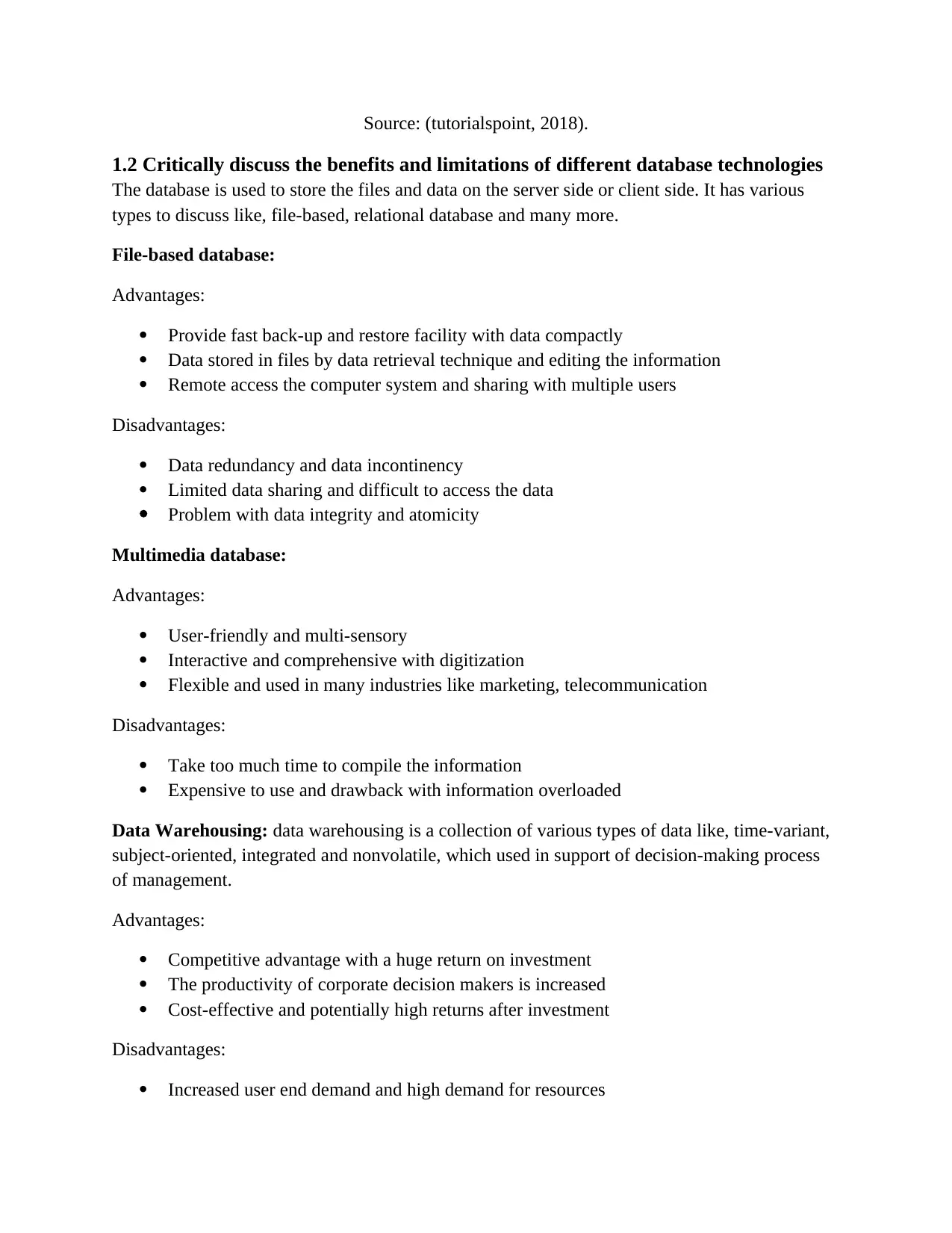
Source: (tutorialspoint, 2018).
1.2 Critically discuss the benefits and limitations of different database technologies
The database is used to store the files and data on the server side or client side. It has various
types to discuss like, file-based, relational database and many more.
File-based database:
Advantages:
Provide fast back-up and restore facility with data compactly
Data stored in files by data retrieval technique and editing the information
Remote access the computer system and sharing with multiple users
Disadvantages:
Data redundancy and data incontinency
Limited data sharing and difficult to access the data
Problem with data integrity and atomicity
Multimedia database:
Advantages:
User-friendly and multi-sensory
Interactive and comprehensive with digitization
Flexible and used in many industries like marketing, telecommunication
Disadvantages:
Take too much time to compile the information
Expensive to use and drawback with information overloaded
Data Warehousing: data warehousing is a collection of various types of data like, time-variant,
subject-oriented, integrated and nonvolatile, which used in support of decision-making process
of management.
Advantages:
Competitive advantage with a huge return on investment
The productivity of corporate decision makers is increased
Cost-effective and potentially high returns after investment
Disadvantages:
Increased user end demand and high demand for resources
1.2 Critically discuss the benefits and limitations of different database technologies
The database is used to store the files and data on the server side or client side. It has various
types to discuss like, file-based, relational database and many more.
File-based database:
Advantages:
Provide fast back-up and restore facility with data compactly
Data stored in files by data retrieval technique and editing the information
Remote access the computer system and sharing with multiple users
Disadvantages:
Data redundancy and data incontinency
Limited data sharing and difficult to access the data
Problem with data integrity and atomicity
Multimedia database:
Advantages:
User-friendly and multi-sensory
Interactive and comprehensive with digitization
Flexible and used in many industries like marketing, telecommunication
Disadvantages:
Take too much time to compile the information
Expensive to use and drawback with information overloaded
Data Warehousing: data warehousing is a collection of various types of data like, time-variant,
subject-oriented, integrated and nonvolatile, which used in support of decision-making process
of management.
Advantages:
Competitive advantage with a huge return on investment
The productivity of corporate decision makers is increased
Cost-effective and potentially high returns after investment
Disadvantages:
Increased user end demand and high demand for resources
⊘ This is a preview!⊘
Do you want full access?
Subscribe today to unlock all pages.

Trusted by 1+ million students worldwide
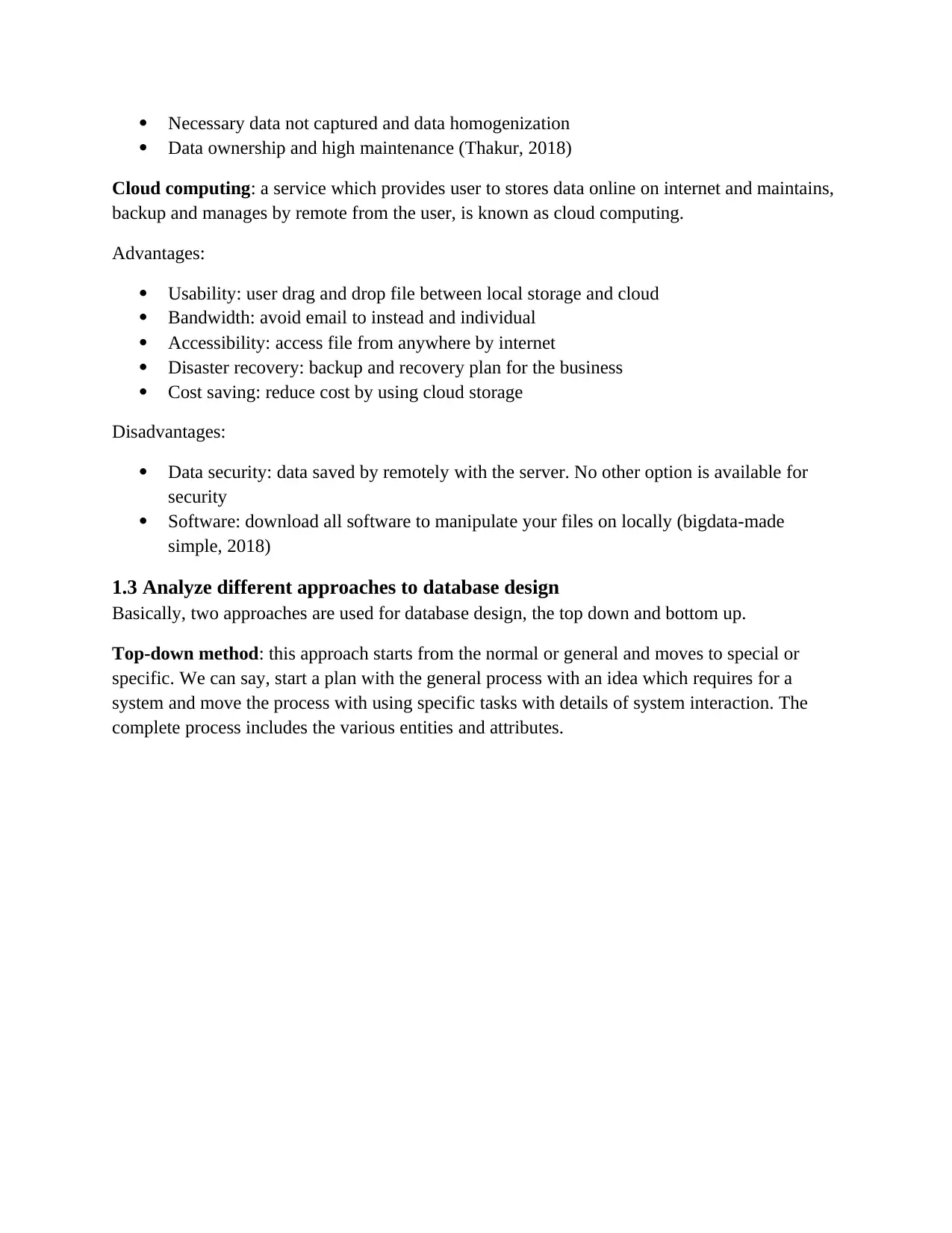
Necessary data not captured and data homogenization
Data ownership and high maintenance (Thakur, 2018)
Cloud computing: a service which provides user to stores data online on internet and maintains,
backup and manages by remote from the user, is known as cloud computing.
Advantages:
Usability: user drag and drop file between local storage and cloud
Bandwidth: avoid email to instead and individual
Accessibility: access file from anywhere by internet
Disaster recovery: backup and recovery plan for the business
Cost saving: reduce cost by using cloud storage
Disadvantages:
Data security: data saved by remotely with the server. No other option is available for
security
Software: download all software to manipulate your files on locally (bigdata-made
simple, 2018)
1.3 Analyze different approaches to database design
Basically, two approaches are used for database design, the top down and bottom up.
Top-down method: this approach starts from the normal or general and moves to special or
specific. We can say, start a plan with the general process with an idea which requires for a
system and move the process with using specific tasks with details of system interaction. The
complete process includes the various entities and attributes.
Data ownership and high maintenance (Thakur, 2018)
Cloud computing: a service which provides user to stores data online on internet and maintains,
backup and manages by remote from the user, is known as cloud computing.
Advantages:
Usability: user drag and drop file between local storage and cloud
Bandwidth: avoid email to instead and individual
Accessibility: access file from anywhere by internet
Disaster recovery: backup and recovery plan for the business
Cost saving: reduce cost by using cloud storage
Disadvantages:
Data security: data saved by remotely with the server. No other option is available for
security
Software: download all software to manipulate your files on locally (bigdata-made
simple, 2018)
1.3 Analyze different approaches to database design
Basically, two approaches are used for database design, the top down and bottom up.
Top-down method: this approach starts from the normal or general and moves to special or
specific. We can say, start a plan with the general process with an idea which requires for a
system and move the process with using specific tasks with details of system interaction. The
complete process includes the various entities and attributes.
Paraphrase This Document
Need a fresh take? Get an instant paraphrase of this document with our AI Paraphraser
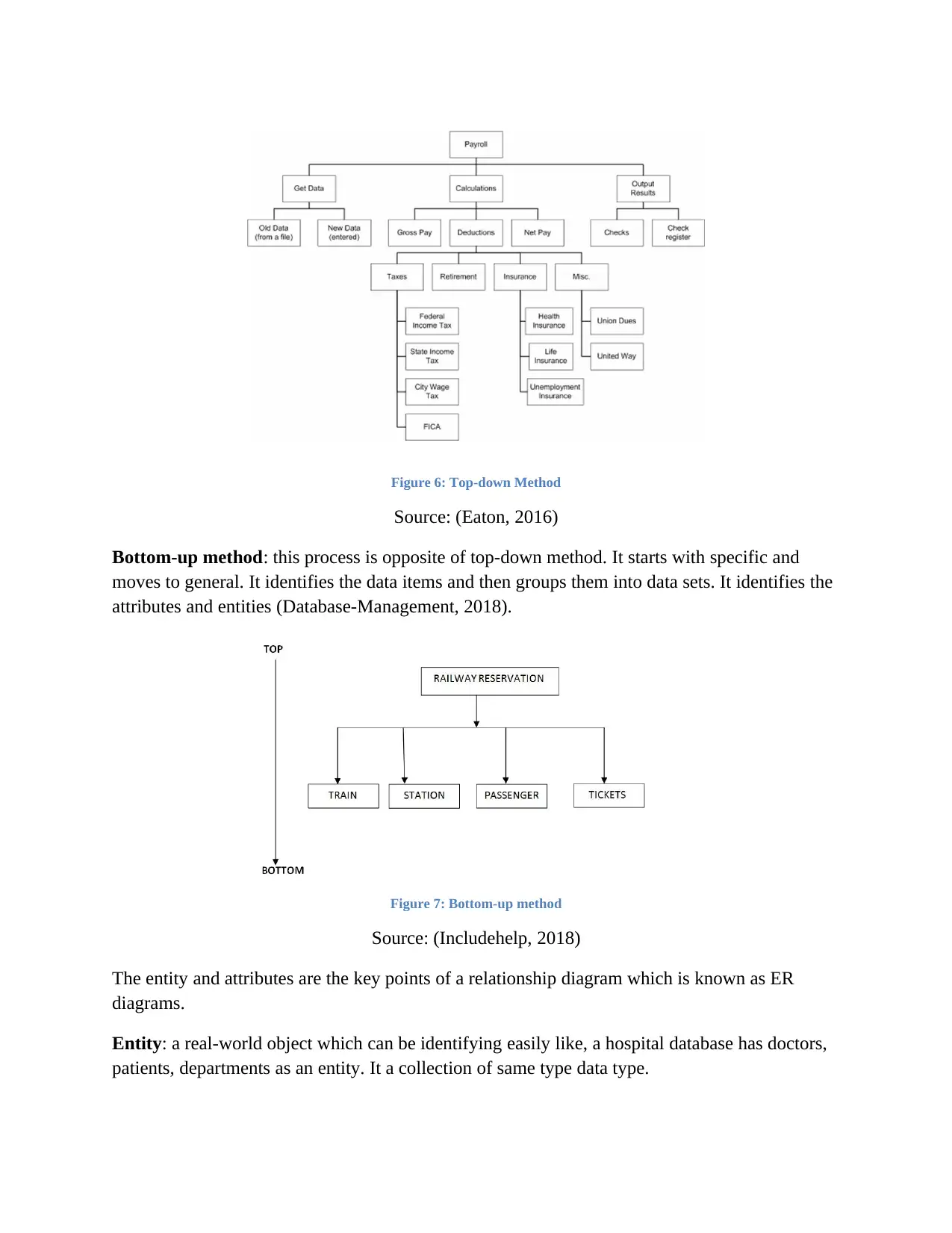
Figure 6: Top-down Method
Source: (Eaton, 2016)
Bottom-up method: this process is opposite of top-down method. It starts with specific and
moves to general. It identifies the data items and then groups them into data sets. It identifies the
attributes and entities (Database-Management, 2018).
Figure 7: Bottom-up method
Source: (Includehelp, 2018)
The entity and attributes are the key points of a relationship diagram which is known as ER
diagrams.
Entity: a real-world object which can be identifying easily like, a hospital database has doctors,
patients, departments as an entity. It a collection of same type data type.
Source: (Eaton, 2016)
Bottom-up method: this process is opposite of top-down method. It starts with specific and
moves to general. It identifies the data items and then groups them into data sets. It identifies the
attributes and entities (Database-Management, 2018).
Figure 7: Bottom-up method
Source: (Includehelp, 2018)
The entity and attributes are the key points of a relationship diagram which is known as ER
diagrams.
Entity: a real-world object which can be identifying easily like, a hospital database has doctors,
patients, departments as an entity. It a collection of same type data type.
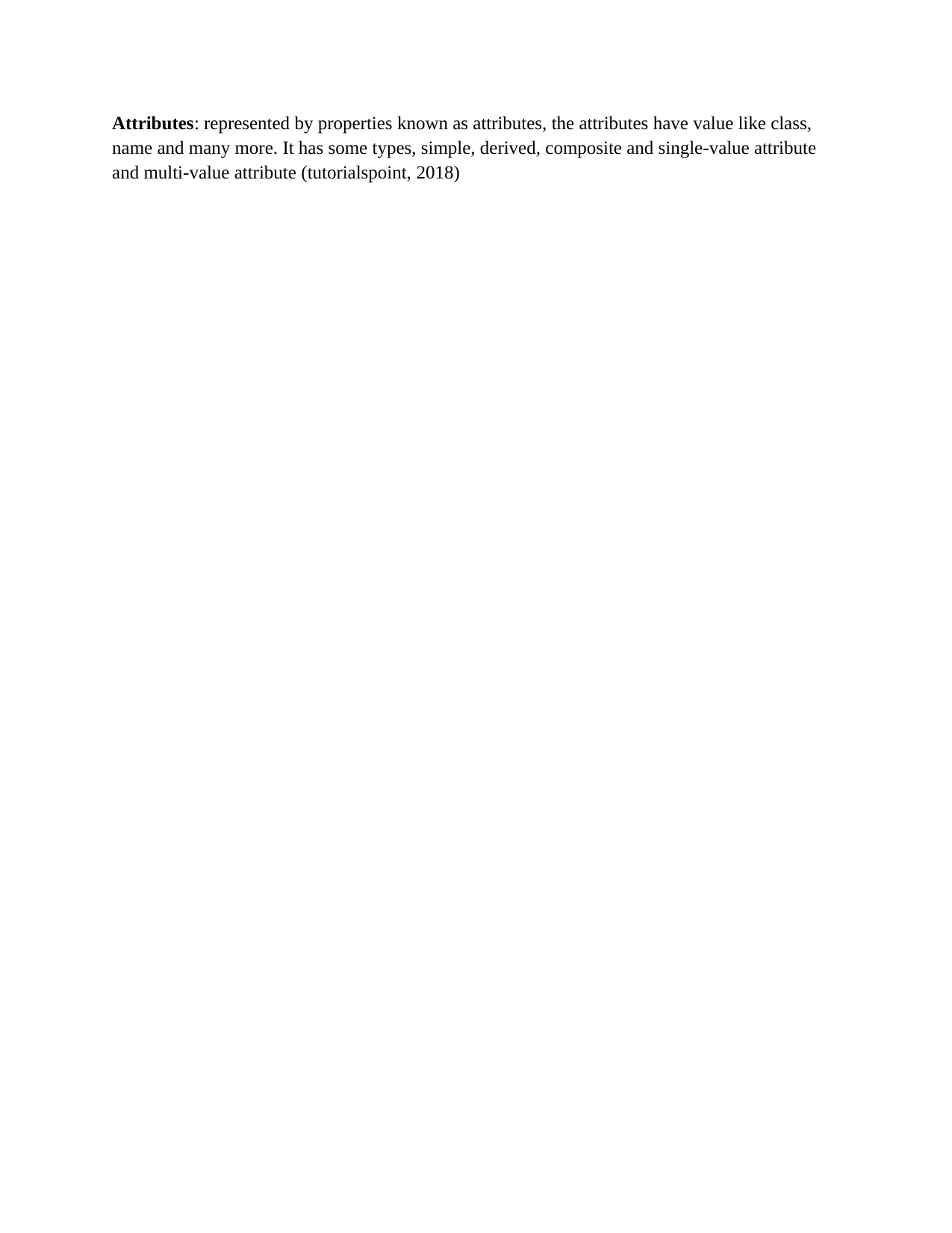
Attributes: represented by properties known as attributes, the attributes have value like class,
name and many more. It has some types, simple, derived, composite and single-value attribute
and multi-value attribute (tutorialspoint, 2018)
name and many more. It has some types, simple, derived, composite and single-value attribute
and multi-value attribute (tutorialspoint, 2018)
⊘ This is a preview!⊘
Do you want full access?
Subscribe today to unlock all pages.

Trusted by 1+ million students worldwide
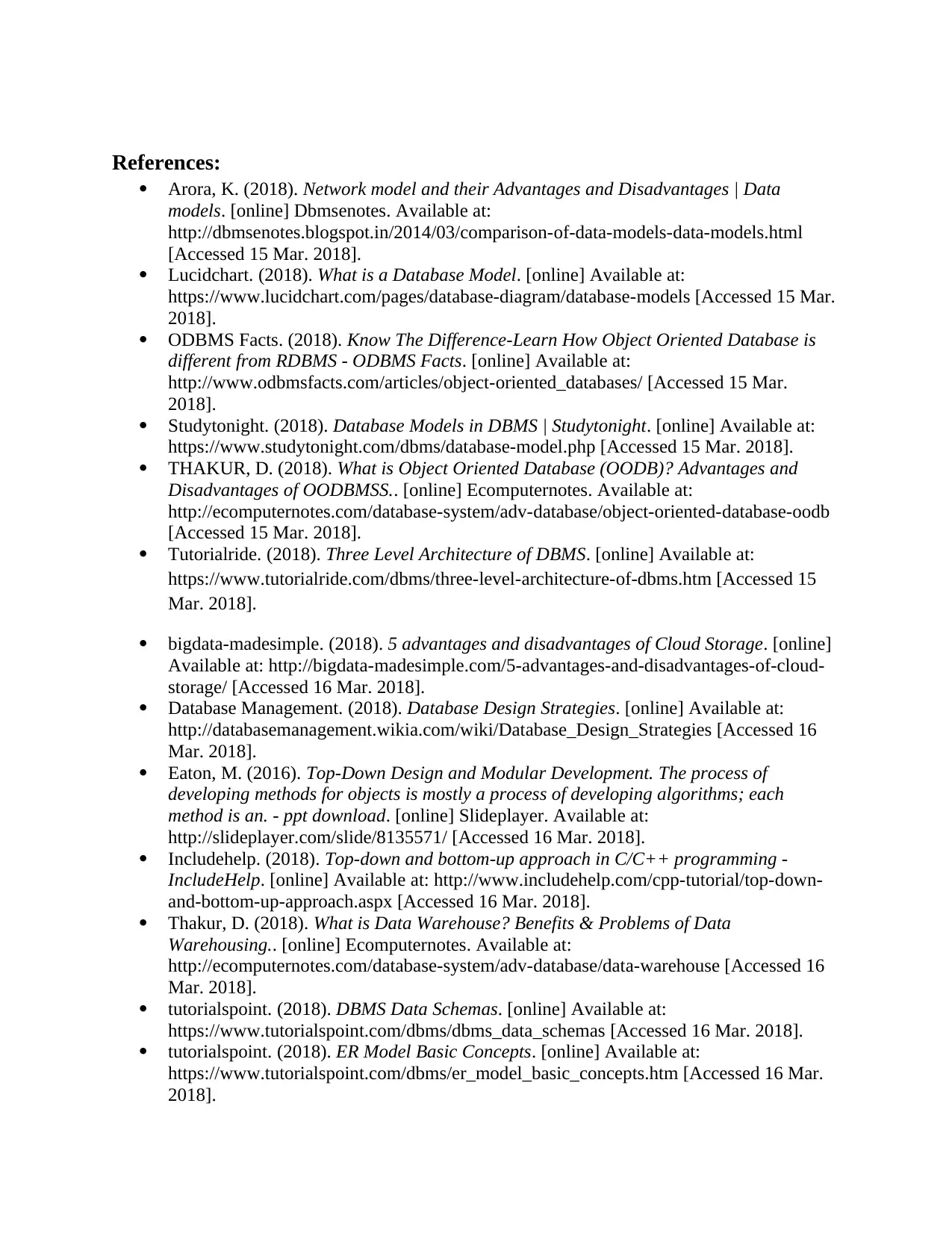
References:
Arora, K. (2018). Network model and their Advantages and Disadvantages | Data
models. [online] Dbmsenotes. Available at:
http://dbmsenotes.blogspot.in/2014/03/comparison-of-data-models-data-models.html
[Accessed 15 Mar. 2018].
Lucidchart. (2018). What is a Database Model. [online] Available at:
https://www.lucidchart.com/pages/database-diagram/database-models [Accessed 15 Mar.
2018].
ODBMS Facts. (2018). Know The Difference-Learn How Object Oriented Database is
different from RDBMS - ODBMS Facts. [online] Available at:
http://www.odbmsfacts.com/articles/object-oriented_databases/ [Accessed 15 Mar.
2018].
Studytonight. (2018). Database Models in DBMS | Studytonight. [online] Available at:
https://www.studytonight.com/dbms/database-model.php [Accessed 15 Mar. 2018].
THAKUR, D. (2018). What is Object Oriented Database (OODB)? Advantages and
Disadvantages of OODBMSS.. [online] Ecomputernotes. Available at:
http://ecomputernotes.com/database-system/adv-database/object-oriented-database-oodb
[Accessed 15 Mar. 2018].
Tutorialride. (2018). Three Level Architecture of DBMS. [online] Available at:
https://www.tutorialride.com/dbms/three-level-architecture-of-dbms.htm [Accessed 15
Mar. 2018].
bigdata-madesimple. (2018). 5 advantages and disadvantages of Cloud Storage. [online]
Available at: http://bigdata-madesimple.com/5-advantages-and-disadvantages-of-cloud-
storage/ [Accessed 16 Mar. 2018].
Database Management. (2018). Database Design Strategies. [online] Available at:
http://databasemanagement.wikia.com/wiki/Database_Design_Strategies [Accessed 16
Mar. 2018].
Eaton, M. (2016). Top-Down Design and Modular Development. The process of
developing methods for objects is mostly a process of developing algorithms; each
method is an. - ppt download. [online] Slideplayer. Available at:
http://slideplayer.com/slide/8135571/ [Accessed 16 Mar. 2018].
Includehelp. (2018). Top-down and bottom-up approach in C/C++ programming -
IncludeHelp. [online] Available at: http://www.includehelp.com/cpp-tutorial/top-down-
and-bottom-up-approach.aspx [Accessed 16 Mar. 2018].
Thakur, D. (2018). What is Data Warehouse? Benefits & Problems of Data
Warehousing.. [online] Ecomputernotes. Available at:
http://ecomputernotes.com/database-system/adv-database/data-warehouse [Accessed 16
Mar. 2018].
tutorialspoint. (2018). DBMS Data Schemas. [online] Available at:
https://www.tutorialspoint.com/dbms/dbms_data_schemas [Accessed 16 Mar. 2018].
tutorialspoint. (2018). ER Model Basic Concepts. [online] Available at:
https://www.tutorialspoint.com/dbms/er_model_basic_concepts.htm [Accessed 16 Mar.
2018].
Arora, K. (2018). Network model and their Advantages and Disadvantages | Data
models. [online] Dbmsenotes. Available at:
http://dbmsenotes.blogspot.in/2014/03/comparison-of-data-models-data-models.html
[Accessed 15 Mar. 2018].
Lucidchart. (2018). What is a Database Model. [online] Available at:
https://www.lucidchart.com/pages/database-diagram/database-models [Accessed 15 Mar.
2018].
ODBMS Facts. (2018). Know The Difference-Learn How Object Oriented Database is
different from RDBMS - ODBMS Facts. [online] Available at:
http://www.odbmsfacts.com/articles/object-oriented_databases/ [Accessed 15 Mar.
2018].
Studytonight. (2018). Database Models in DBMS | Studytonight. [online] Available at:
https://www.studytonight.com/dbms/database-model.php [Accessed 15 Mar. 2018].
THAKUR, D. (2018). What is Object Oriented Database (OODB)? Advantages and
Disadvantages of OODBMSS.. [online] Ecomputernotes. Available at:
http://ecomputernotes.com/database-system/adv-database/object-oriented-database-oodb
[Accessed 15 Mar. 2018].
Tutorialride. (2018). Three Level Architecture of DBMS. [online] Available at:
https://www.tutorialride.com/dbms/three-level-architecture-of-dbms.htm [Accessed 15
Mar. 2018].
bigdata-madesimple. (2018). 5 advantages and disadvantages of Cloud Storage. [online]
Available at: http://bigdata-madesimple.com/5-advantages-and-disadvantages-of-cloud-
storage/ [Accessed 16 Mar. 2018].
Database Management. (2018). Database Design Strategies. [online] Available at:
http://databasemanagement.wikia.com/wiki/Database_Design_Strategies [Accessed 16
Mar. 2018].
Eaton, M. (2016). Top-Down Design and Modular Development. The process of
developing methods for objects is mostly a process of developing algorithms; each
method is an. - ppt download. [online] Slideplayer. Available at:
http://slideplayer.com/slide/8135571/ [Accessed 16 Mar. 2018].
Includehelp. (2018). Top-down and bottom-up approach in C/C++ programming -
IncludeHelp. [online] Available at: http://www.includehelp.com/cpp-tutorial/top-down-
and-bottom-up-approach.aspx [Accessed 16 Mar. 2018].
Thakur, D. (2018). What is Data Warehouse? Benefits & Problems of Data
Warehousing.. [online] Ecomputernotes. Available at:
http://ecomputernotes.com/database-system/adv-database/data-warehouse [Accessed 16
Mar. 2018].
tutorialspoint. (2018). DBMS Data Schemas. [online] Available at:
https://www.tutorialspoint.com/dbms/dbms_data_schemas [Accessed 16 Mar. 2018].
tutorialspoint. (2018). ER Model Basic Concepts. [online] Available at:
https://www.tutorialspoint.com/dbms/er_model_basic_concepts.htm [Accessed 16 Mar.
2018].
Paraphrase This Document
Need a fresh take? Get an instant paraphrase of this document with our AI Paraphraser


.
⊘ This is a preview!⊘
Do you want full access?
Subscribe today to unlock all pages.

Trusted by 1+ million students worldwide
1 out of 12
Related Documents
Your All-in-One AI-Powered Toolkit for Academic Success.
+13062052269
info@desklib.com
Available 24*7 on WhatsApp / Email
![[object Object]](/_next/static/media/star-bottom.7253800d.svg)
Unlock your academic potential
Copyright © 2020–2025 A2Z Services. All Rights Reserved. Developed and managed by ZUCOL.





